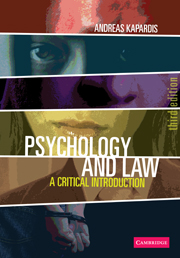Book contents
- Frontmatter
- Contents
- List of case studies
- Acknowledgements
- Foreword
- 1 Psycholegal Research: An Introduction
- 2 Eyewitnesses: Key Issues and Event Characteristics
- 3 Eyewitnesses: The Perpetrator and Interviewing
- 4 Children as Witnesses
- 5 The Jury
- 6 Sentencing as a Human Process, Victims, and Restorative Justice
- 7 The Psychologists as Expert Witnesses
- 8 Detecting Deception
- 9 Witness Recognition Procedures
- 10 Psychology and the Police
- 11 Conclusions
- Notes
- References
- Index
5 - The Jury
- Frontmatter
- Contents
- List of case studies
- Acknowledgements
- Foreword
- 1 Psycholegal Research: An Introduction
- 2 Eyewitnesses: Key Issues and Event Characteristics
- 3 Eyewitnesses: The Perpetrator and Interviewing
- 4 Children as Witnesses
- 5 The Jury
- 6 Sentencing as a Human Process, Victims, and Restorative Justice
- 7 The Psychologists as Expert Witnesses
- 8 Detecting Deception
- 9 Witness Recognition Procedures
- 10 Psychology and the Police
- 11 Conclusions
- Notes
- References
- Index
Summary
No freeman shall be seized, or imprisoned, or disposed or outlawed, or in any way destroyed; nor will we condemn him, nor will we commit him to prison, excepting by the lawful judgement of his peers, or by the law of the land.
(Clause 39, Magna Carta 1215)A better instrument could scarcely be imagined for achieving uncertainty, capriciousness, lack of uniformity, disregard of former decisions – utter unpredictability.
(Judge Jerome Frank, 1949:172)In short, contrary to the worst fears, scientific [jury] selection procedures cannot reliably tip the scales of justice.
(Kassin and Wrightsman, 1988:61)INTRODUCTION
In The Book of Magna Carta, Hindley (1990:ix–x) comments that the words in the above quotation from clause 39, which has been the basis for the institution of trial by jury, ‘coined by a distant society in a half-forgotten language, have been treasured by generations of men and women in the English-speaking world as a safeguard of individual liberty’. Darbyshire (1991:742), however, reminds us that, contrary to popular belief, legal historians (for example, Holdsworth, 1903:59) have pointed out (but have gone largely unnoticed by students of the jury) that clause 39 has nothing to do with trial by jury. The notion of being tried by one's peers existed long before the Magna Carta. The conclusion reached in the pages that follow is that the weight of the evidence from both experimental simulation and studies of actual juries/jurors is that the jury system in western English-speaking common law countries has been in decline and is not a reliable, sound method of determining whether a defendant is guilty or innocent.
- Type
- Chapter
- Information
- Psychology and LawA Critical Introduction, pp. 148 - 194Publisher: Cambridge University PressPrint publication year: 2009

